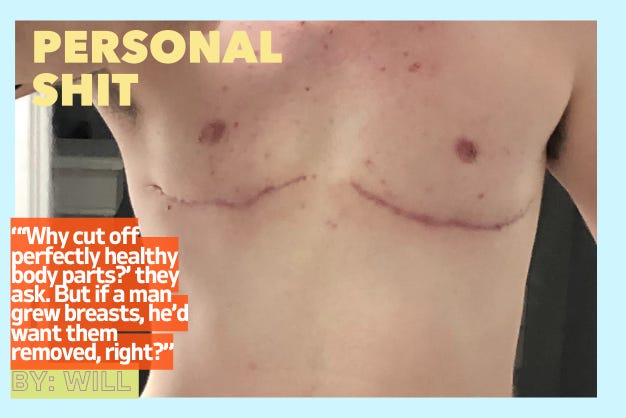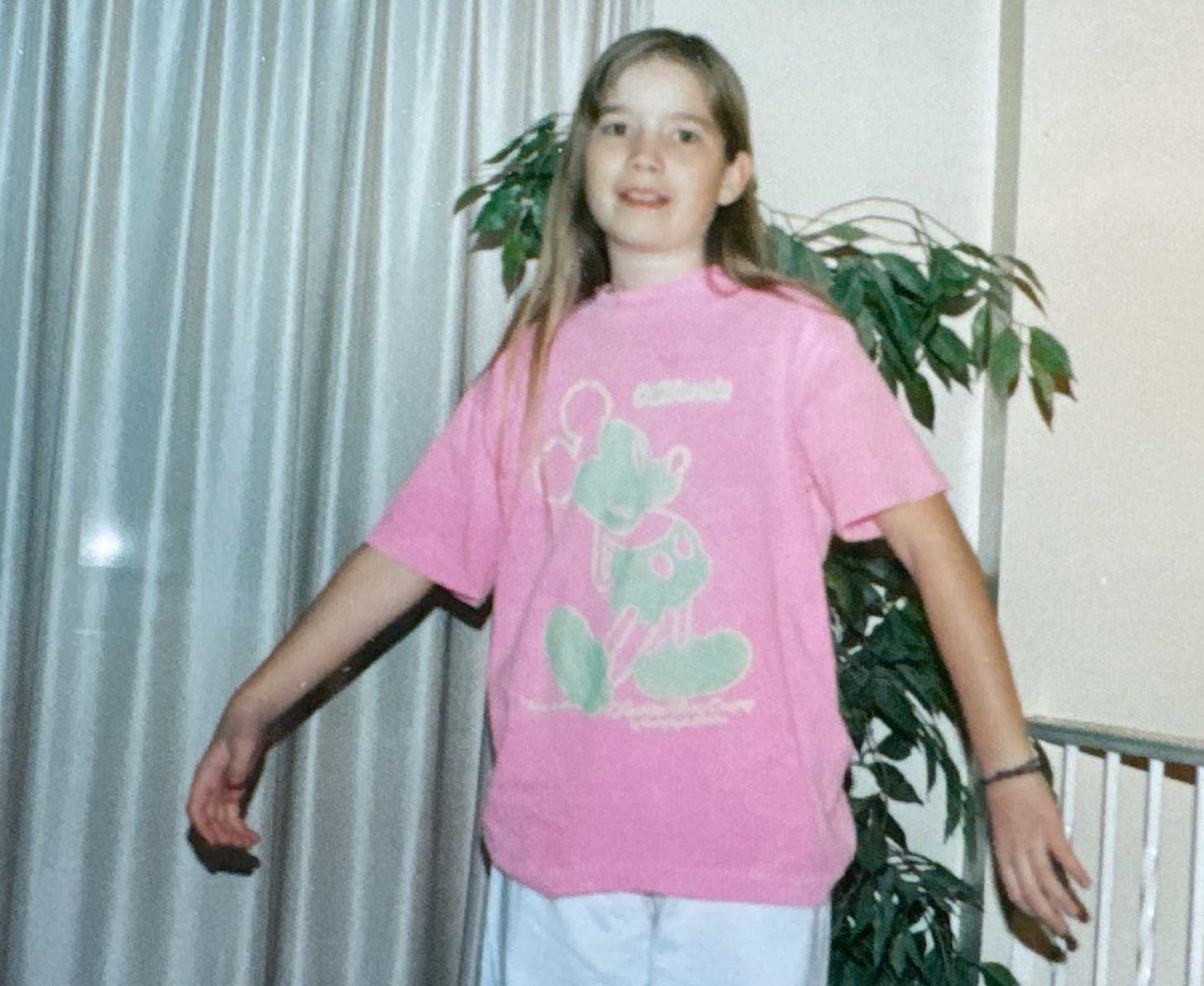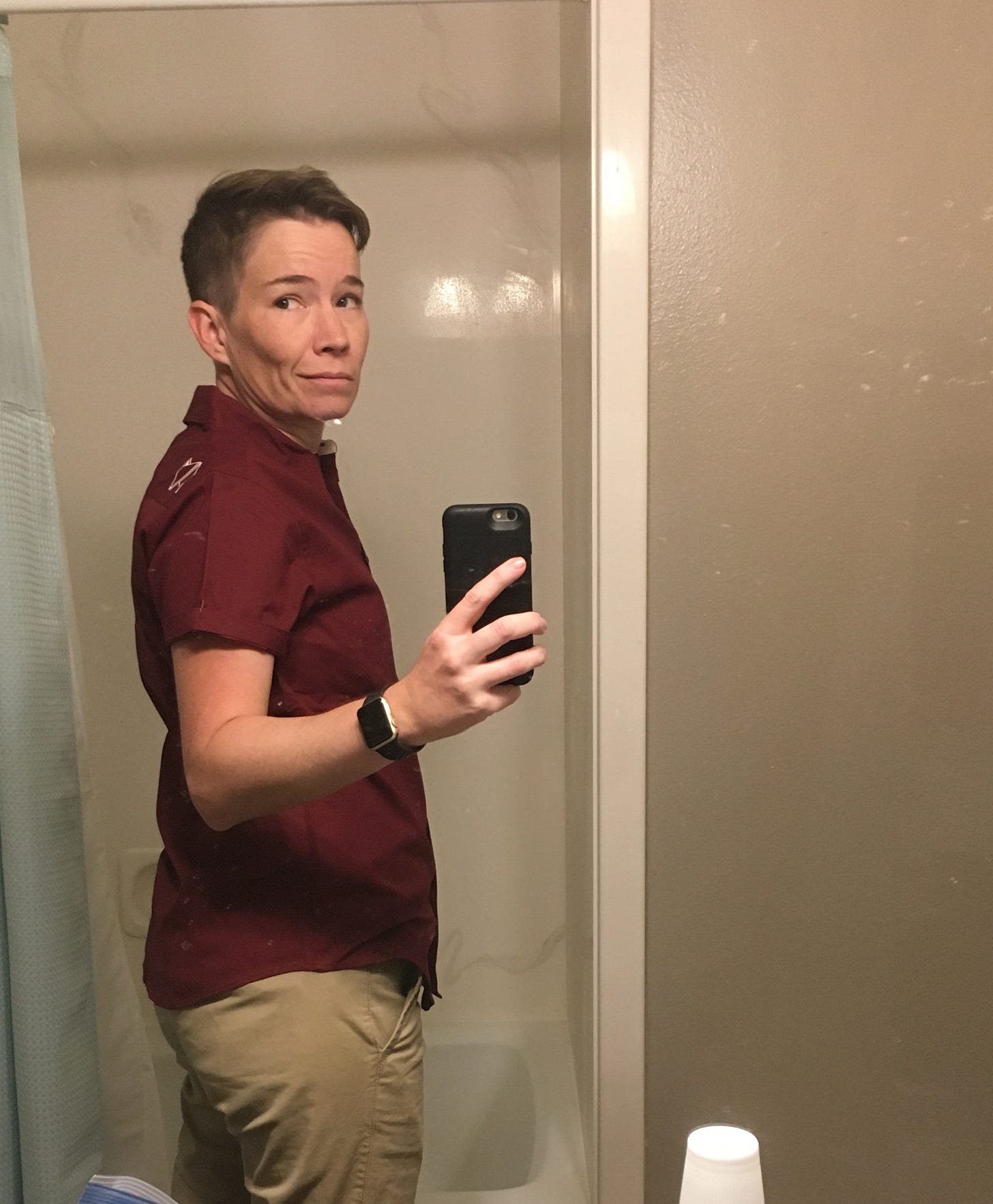Getting Rid Of The Breasts That Were Never Really Mine — A Visual Timeline
As a toddler, I was horrified to realize that I would grow up to have breasts like my mom. As mine changed through adolescence, adulthood and breastfeeding, my relationship to them got so complicated.
Hi and welcome, short week after Labor Day!
Thank you all for hanging out with me in the comments this weekend. It was super fun and not ever dull, in part because of all your well-articulated differences of opinion. Now as for the AJPT story we are sending you today, here are some things about the writer, Will:
His openness astounds me and is, I believe, truly helpful to people who are hiding anything at all (i.e. all of us).
He wrote these other (I think incredible and revealing) accounts here also, if you haven’t read them already.
I got to hug him when he came to an NYC conference for Open Secrets magazine where I was the keynote speaker. I love all of the elements in that sentence, Will’s hug especially. He is warm.
I am so lucky that Will wants to write for me and you here. If you want to write for AJPT also, I would love it (and I say this even though I am a little inundated at the moment but will catch up). So do what Will did months before we got to meet in person and send me your submissions at Jane@anotherjaneprattthing.com, especially entries for the legendary It Happened To Me column (circa Sassy 1988) or that xoJane-conceived favorite, Unpopular Opinion.
Keep on truckin’!*
-Jane
*My brilliant mom ended a text to me yesterday with that phrase and I thought it was so much better than other current phrases that are hurting me. So I'm stealing it from her and using it here, hoping to give it a revival. Tell me any oldie by goodie expressions you like in the comments and I promise to use them widely again too. See you there! (Plus that’s a good time to also thank Will for sharing this story if you want to, because he certainly didn’t have to.)
By Will Cole
As a trans man, my relationship with my chest has been complicated. One weekend in early 2018, I had the house to myself while my husband and teenage son traveled. I showered, as usual, in the dim light from the frosted bathroom window. In autopilot, I wrapped a towel around myself, tucked under the armpits. Glancing at my reflection in the mirror, I felt, as usual, surprised and disappointed.
Determined to fix my distress, I unwrapped and repositioned the towel around my hips. I raised my arms high above my head, minimizing the A-cup lumps on my chest. In this position, it almost looked like a proper chest, like pecs. I felt a fleeting sense of potential.
Given a choice, I would have stayed in the wonderful state of androgyny. In my conservative Mormon upbringing, I knew phrases like “bathing suit areas” and “private parts.”
I wanted to swim shirtless, but wasn’t allowed to
I learned “boys have penises; girls don’t.” For all I knew about my body, I might as well have been a Ken doll. As a toddler, when I realized I would grow up to have breasts like mom, not whiskers like dad, I was horrified.
When my mom took us kids to swim in the shallows of the lake, I begged her to let me swim like my brothers, shirtless. She insisted my sister and I wear shirts, though any difference between my brothers’ chests and mine was indiscernible. My chest ached to be free. I solved the problem by wearing the shirt and actively trying to forget about it—denial.
My mom bought me my first training bras
On the first day of sixth grade, the problem of breasts reappeared without warning. Amber, the designated prettiest girl in my class—crimped hair, blue eyes, Esprit shirts and Guess jeans—grabbed my shoulders, spun me around, and raked her manicured fingernails down my back.
I hoped the lumps were cancer; then they’d have to remove them, right?
I whirled back around, confused, searching for an explanation in her smug expression. I sensed she and her big-banged blonde hair had deemed me unworthy of something beyond my ken. In horror, it clicked; she was checking for my nonexistent bra strap. Somehow, I knew I should not reveal that I was relieved to be flat-chested. The rest of the school year, while Amber and the others tracked and discussed each girl’s development like a Ken Burns documentary, I hovered on the sideline, mute, panicked.
Toweling off my chest after a shower one day, I felt a lump. Like an alien. But I knew what it was from the fifth-grade Maturation Day video. I was developing.
I pressed my hands onto the buds to prevent any growth. I slept on my stomach. I hoped the lumps were cancer; then they’d have to remove them, right? I ignored them, never spoke of them, never looked at them, hated them.
One week before seventh grade, my mom handed me a plastic shopping bag. Mom never shopped for me without me; when it came to clothes, I was finicky. Why does everything have ruffles, lace, butterflies, or sparkles?
“For PE,” she said.
My face must have betrayed how I felt: perplexed.
“In the locker room. You’ll have to change. With the other girls.”
Eyes wide, heart pounding in my ears, I opened the bag just enough to identify its contents before clapping it shut again: lacey, white training bras. I failed to muster a thank you before slinking off to my basement bedroom, my face aflame.
In the fall of eighth grade, on Friday the 13th no less, I was on a sleepover with my best friend at my aunt’s house, babysitting. The spot of blood on my underwear didn’t surprise or please me; it disappointed me. My first “time of the month.” Mortified, I snuck into the primary bathroom and rummaged around under my aunt’s bathroom sink, hoping for and dreading a maxi pad. Coming up empty-handed, I subbed in some folded-up toilet paper and prayed. Sleeping next to my friend on the living room floor, silent about my troubles, perseverating about blood.
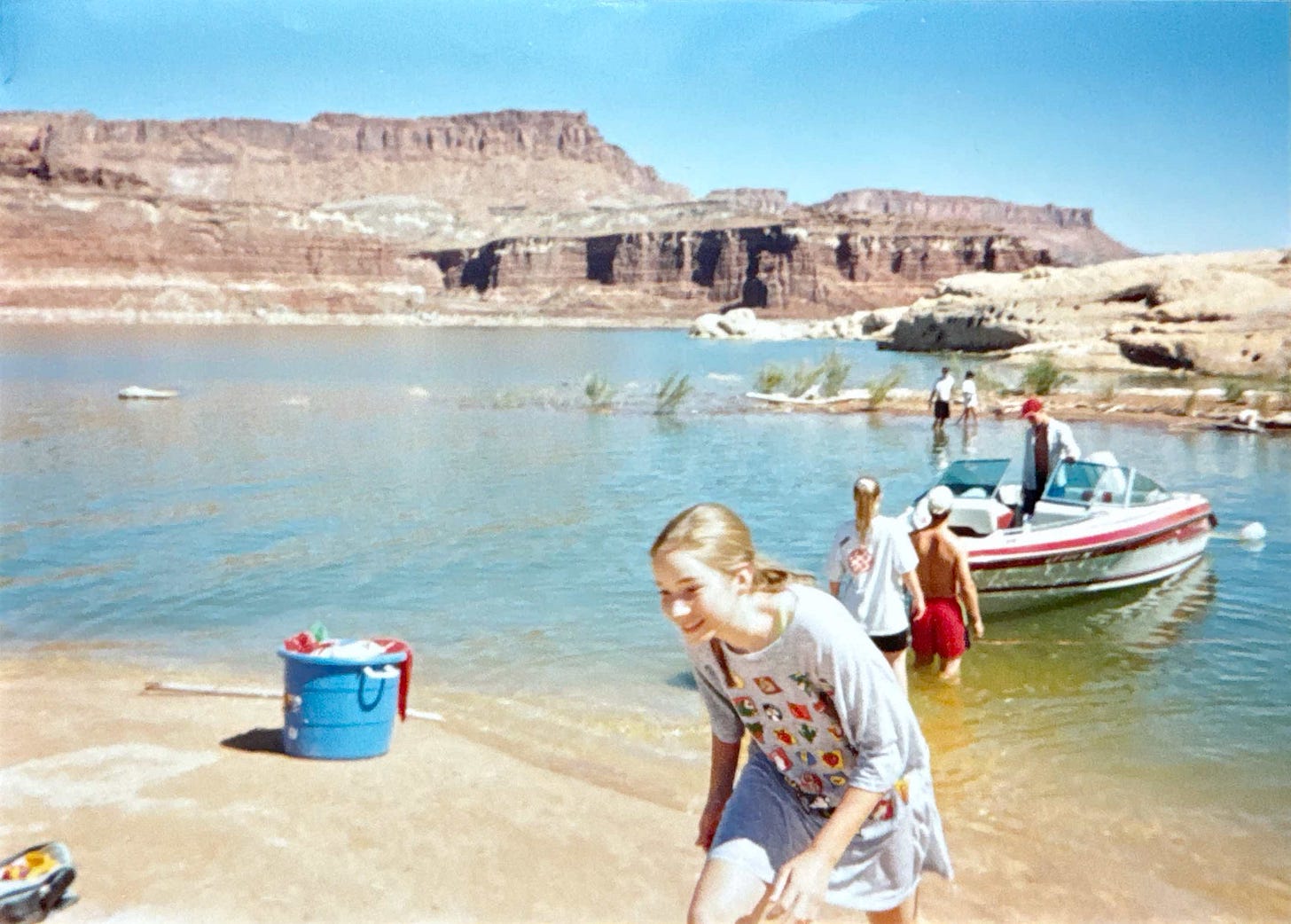
I never told my aunt. Or my friend. Or my mom. The thought of her gushing about me being a woman now, like I’d seen in the sitcoms, was horrifying. How was I supposed to be happy about bleeding every month for decades? I did tell my big sister. A few days later, my mom broached the subject with a soft demeanor, “I heard you got your period?”
My reply was more mute mortification. Once, I sent a message through my sister about wanting more mini pads, for light days, instead of the Extra Super-size pads that my friends called surfboards. Soon, I found small and normal-sized pads in The Drawer. Thanks, Mom.
My big-busted friends schemed to catch me with my shirt off
My girlfriends bragged at every opportunity about their B- and C-cups, adjusting themselves in hallway mirrors, primping. Confused and embarrassed, I witnessed the boys snap girls’ bra straps, ogle their cleavage. I hid my barely A-cup chest under baggy shirts; Mormon sensibilities reinforced my modesty and provided a ready excuse for being frumpy.
My big-busted friends expected me to be envious, but it wasn’t envy. I avoided mirrors like a vampire and showered in a rush without glancing at my chest. In the bedroom I shared with my big sister, we turned our backs to change. In the PE locker room (where the girls were not required to shower, blessed be!), I mastered a technique to swap my shirts without ever being shirtless or revealing my training bra. But the technique didn’t work with button-up shirts. Instead, I’d slip away to one of the curtained shower stalls.
One of the Britney/Brittni/Brittanys (all of them bullies) once followed me to the stall, determined to swipe the curtain aside to expose me, mortify me. Hearing her approach, I gripped each side of the vinyl curtain and held it open in a vice grip. I dared her to try (in my head), feet wide, jaw clenched. After a couple of silent attempts, Britney/Brittni/Brittany powerwalked away, huffing. I released my breath.
In my sophomore year, my younger sister entered seventh grade and the same PE locker room I’d endured. Rather than getting her own set, she started wearing my training bras. By then, the cotton was wearing thin, the seams gaping with holes. Rather than ask for replacements, I stitched them up with my meager hand-sewing skills, or I wore them backwards.
Mom overheard my sister and me discussing the newest holes and presented us with new bras, real bras, with cups I could never quite fill. At school, baby-tees came into fashion, but I persisted in my baggy, formless disguise.
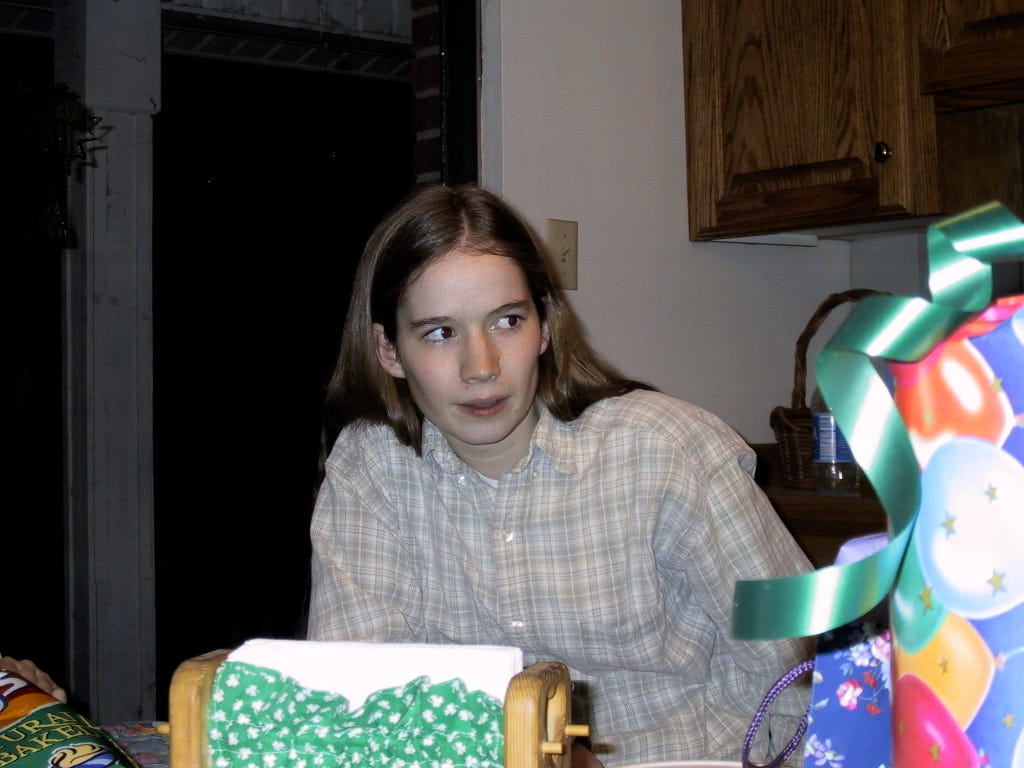
And the bathing suits—one-piece suits, of course. My mom would have refused to buy a two-piece, had it occurred to me to ask. This was long before prolonged sun exposure was a bad thing; swim shirts and shorts for girls didn’t exist yet. I couldn’t decide which was worse: exposing my inner, upper thighs or announcing the existence of my nipples on my spandex-flattened, flat chest. The suits with built-in bra padding repulsed me, their womanliness threatening to suffocate me in shame. For years, I covered my swimsuit with a large cotton T-shirt. In high school, I wore soccer shorts over my swimsuit, now that hair had developed down there.
At swimming parties, boys would persuade girls out of their extra shorts, Come on, it’s no big deal. When their words failed, they’d team up to yank them off, one boy grabbing a girl from behind, the other pulling at her kicking legs while she squealed. Dreading this fate, I tied the drawstring tight and kept one hand near my waistline for when Darren or Mitch pounced.
I breastfed like a good Mormon
Not long after high school, still a good Mormon, I married. My husband was the first person to touch my chest, the evening of our wedding. Well, before that, when we were dating, he may or may not have gotten in some side-boob action. And some fully clothed activities I was never sure qualified as the forbidden “necking” and “petting.” But I was terrified this was my path to hell and, before the wedding, confessed.
When I gave birth three years later, I became a hardcore breastfeeder. I’d nurse my baby anywhere, anytime, others’ discomfort be damned. This is what breasts are meant to do, dagnabbit! My sister was breastfeeding her baby at the same time, and we’d compete about how our breasts had transformed.
“Mine are so full, they’re as big as grapefruits,” I’d say.
She’d counter, “Well, mine are cantaloupes!” Afterwards, mine settled into an A-cup, a tad larger than before—and droopier. I still felt the familiar uneasiness about my breasts, but explained it away as B-cup envy. But imagining bigger than that was humiliating.
When I left Mormonism in my mid-20s, my husband nudged me to drop my tomboy style, to try out femininity. Tank tops, spaghetti straps, tighter pants. Clueless as to what styles and fit I liked for myself, I let my husband dress me, my own Henry Higgins. As the tops got tighter, I stuffed baby socks into my bras before switching to padded ones. I call those years in my late 20s my feminine era, when I double-pierced my ears and nose, carried a purse for the first time, and noticed that men turned their heads to watch me sashay past. I’d never thought of myself as attractive before; this new look felt sexy, delightful.
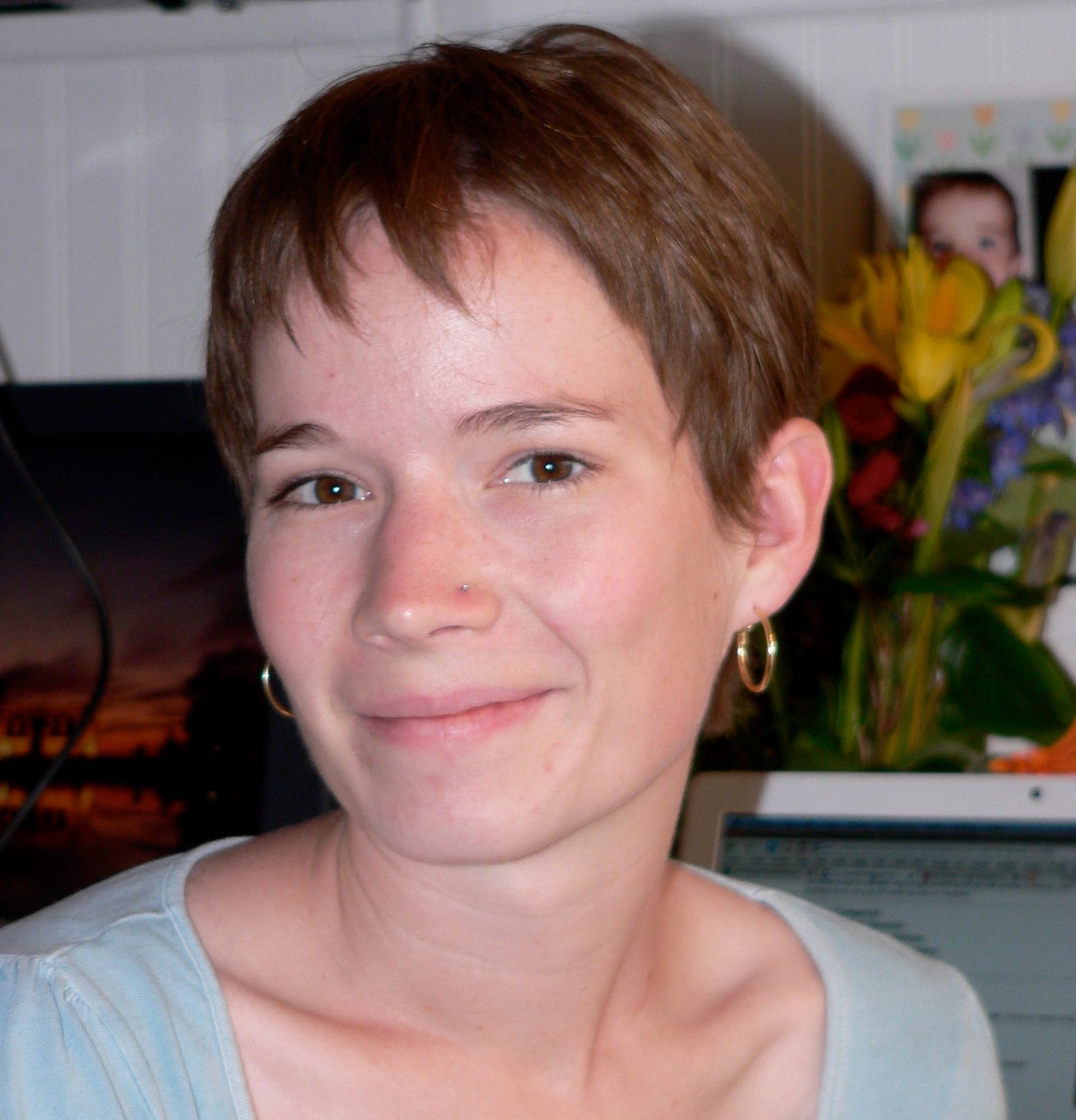
The sexy, feminine me didn’t last. In my 30s, I switched my style back to frumpy, modest comfort. I dropped the padded bras for sports bras and camisole undershirts that flattened rather than flattered.
I threw out my bras and began chest binding
When I first heard the terms genderqueer and nonbinary around 2016, a hidden box in my head labeled “Gender” clicked open. The minute I read about chest binding, I craved it. With the flat-chested effect of my first gc2b binder, I exploded with euphoria. My confidence soared. For the first time since toddlerhood, I felt in my body.
“You might guess that cisgender women with double-Ds, Es, and Gs—or teenage trans boys, if you believe the right-wing fearmongering—account for most breast reduction surgeries. But no.”
Back when I wore women’s business casual, I’d walk with shoulders hunched, body glued to the wall, softening the click clack of my shoes. Chest bound, though, I strutted down the hallways at work, my flat chest puffed out, grinning at the echo of my boots’ clunk clunk.
Chest dysphoria and flat-chested euphoria were not the only experiences that helped me grasp that I am trans. But after years of exploring, I came out, separated from my husband, and threw out all my bras. Chest binders became my constant companion, my second skin. But binders were only a temporary solution.
Panic attacks meant it was time for me to have top surgery
During my first appointment with an ob-gyn as an out trans man, I spiraled. Not because of the cold speculum and routine Pap smear, but because of the breast exam.
When the nurse instructed me to get undressed and put on a paper gown, I hadn't considered removing my binder. Through the breast exam, I shook and suppressed sobs. After that panic attack, I knew it was time to start jumping through the bureaucratic hoops. I needed top surgery (double mastectomy and chest masculinization).
Many outsiders don’t understand. “Why cut off perfectly healthy body parts?” they ask. Their question are not bids for understanding; they are dismissals. But here’s one answer:
Keep reading with a 7-day free trial
Subscribe to Another Jane Pratt Thing to keep reading this post and get 7 days of free access to the full post archives.


